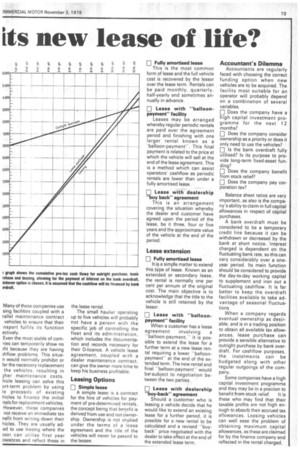its new lease of life?
Page 81

If you've noticed an error in this article please click here to report it so we can fix it.
Many of these companies use sing facilities coupled with a rallel maintenance contract vehicles to ensure that their nsport fulfils its function ectively.
Even the most stable of cornlies can temporarily show no fit because they are having 5hflow problems. This situan would normally prohibit or fer the necessary replacement the vehicles, resulting in her maintenance costs. hicle leasing can solve this ort-term problem by using le proceeds of existing hides to finance the initial itals for replacement vehicles. However, these companies not receive an immediate tax nef it from writing •down their hicles. They are usually ad ed to use leasing where the ssor can utilise first year owances and reflect these in the lease rental.
The small haulier operating up to five vehicles will probably not have a person with the specific job of controlling the fleet and its administration, which includes the documentation and records necessary for their 0-licence. A vehicle lease agreement, coupled with a dealer maintenance contract, can give the owner more time to keep his business profitable.
Leasing Options El Simple lease
A simple lease is a contract for the hire of vehicles for payment of pre-determined rentals, the concept being that benefit is derived from use and not ownership. Ownership is not implied under the terms of a lease agreement and the title of the vehicles will never be passed to the lessee. Fully amortised lease This is the most common form of lease and the full vehicle cost is recovered by the lessor over the lease term. Rentals can be paid monthly, quarterly, half-yearly and sometimes annually in advance.
fp Lease with "balloonpayment" facility Leases may be arranged whereby regular periodic rentals are paid over the agreement period and finishing with one larger rental known as a 'balloon-payment". This final payment is related to the price at which the vehicle will sell at the end of the lease agreement. This is a method which can assist operators' cashflow as periodic rentals are lower than under a fully amortised lease.
CI Lease with dealership "buy back" agreement
This is an arrangement covering the situation whereby the dealer and customer-have agreed upon the period of the lease, be it three, four or five years and the approximate value of the vehicle at the end of the period.
Lease extension • Fully amortised lease It is a simple matter to extend this type of lease, Known as an extended or secondary lease, the rental is normally one per cent per annum of the original cost. The main objective is to acknowledge that the title to the vehicle is still retained by the lessor.
O Lease with "balloonpayment" facility When a customer has a lease agreement involving a "balloon-payment," it is possible to extend the lease for a further term at a new lease rental requiring a lower "balloonpayment" at the end of the extended term. The new rental and final "balloon-payment" would be'subject to negotiation between the two parties.
El Lease with dealership "buy-back" agreement
Should a customer who is leasing a vehicle decide that he would like to extend an existing lease for a further period, it is possible for a new rental to be calculated and a revised "buyback" price negotiated with the dealer to take effect at the end of the extended lease term.
Accountant's Dilemma
Accountants are regularly faced with choosing the correct funding option when new vehicles are to be acquired. The facility most suitable for an operator will probably depend on a combination of several variables.
0 Does the company have a high capital investment programme for the next 12 months?
O Does the company consider ownership as a priority or does it only need to use the vehicles?
LI Is the bank overdraft fully utilised? Is its purpose to provide long-term fixed-asset funding?
O Does the company benefit from stock relief?
O Does the company pay corporation tax?
Balance sheet ratios are very important, as also is the company's ability to claim in full capital allowances in respect of capital purchases.
A bank overdraft must be considered to be a temporary credit line because it can be withdrawn or decreased by the bank at short notice. Interest charged is dependent on the fluctuating bank rate, so this can vary considerably over a oneyear period. Its main function should be considered to provide the day-to-day working capital to supplement and iron out a fluctuating cashflow. It is far better to keep the overdraft facilities available to take advantage of seasonal fluctuations.
When a company regards eventual ownership as desirable, and is in a trading position to obtain all available tax allowances, lease purchase can provide a sensible alternative to outright purchase by bank overdraft. For cashflow purposes, the instalments can be budgeted along with other regular outgoings of the cornpany.
Some companies have a high capital investment programme and they may be in a position to benefit from stock relief. It is these who may find that their taxable profits are not high en ough to absorb their accrued tax allowances. Leasing vehicles can well ease the problem of obtaining maximum capital allowances, as these are claimed for by the finance company and reflected in the rental charged.




























































































































